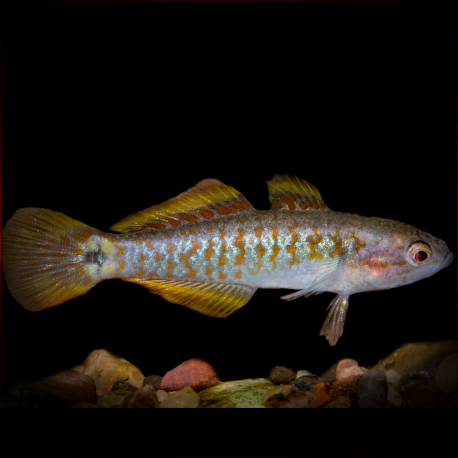More info
Datasheet
| Minimum Tank Size | 40 litres / 10.57 US gallons |
| Maximum Size | 7.5cm / 2.95inches |
| Temperature | 22°C / 71.60°F - 26°C / 78.80°F |
| Hardness | 5-10ºdH |
| pH | 6.5-7.5 |
General Description
The Peacock Goby, scientifically known as Tateurndina Ocellicauda, is a striking member of the Eleotridae family, commonly referred to as sleepers or gudgeons. Despite its name, it is not a true goby and possesses distinct characteristics such as the absence of fused pectoral fins. This species is among the smaller and aesthetically pleasing members of its family, making it an excellent addition to planted community aquariums.
Aquarium Setup
The Peacock Goby thrives in soft, slightly acidic water and flourishes with ample hiding spots. Dark substrate, floating vegetation, bogwood, and dense planting contribute to the fish feeling secure and showcasing vibrant coloration. To facilitate active behavior, avoid high water flow in the tank and seal any gaps in the tank cover, as these gobies are proficient jumpers. Refer to the table for specific water parameter requirements.
Behaviour
While the Peacock Goby can exhibit territorial tendencies towards its kind, it generally coexists well with various small, peaceful fish species. It can be housed with other Papua New Guinea natives like Popondetta sp. rainbowfish, tetras, rasboras, and Corydoras cats. When kept in groups, these gobies engage in minor squabbles that primarily manifest as displays and flaring, enhancing the visual appeal within the aquarium.
Feeding and Diet
Although the Peacock Goby can acclimate to dried food, it thrives on a diet consisting mostly of small live and frozen foods like bloodworms, daphnia, and brine shrimp. This diet not only improves the fish's coloration but also accelerates the onset of spawning conditions, making it essential for their overall health and breeding success.
Reproduction & Dimorphism
Breeding the Peacock Goby is relatively straightforward under suitable conditions, with the fish showcasing unique spawning behaviors. Males court gravid females by flaring their fins and guiding them into caves for egg deposition. It is crucial to provide adequate caves and cover for successful breeding. Mature males display vibrant colors, nuchal humps, and are slightly larger than females. Additionally, females exhibit a yellow hue on their bellies absent in males, with distinguishable characteristics visible in the anal fins.
Habitat and Distribution
Indigenous to Papua New Guinea, the Peacock Goby inhabits lowland streams, ponds, and rivers predominantly located in the eastern regions of the island. They are commonly found in lush rainforest environments where they tend to form loose shoals, contributing to the dynamic aquatic ecosystems in their natural habitats.

